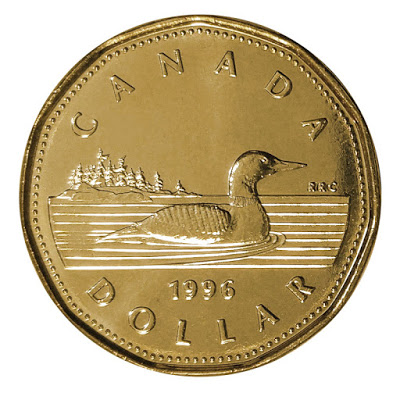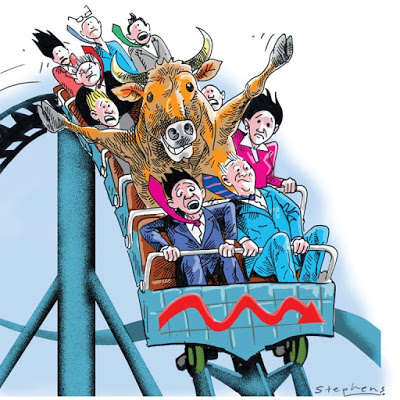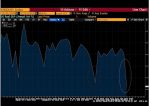The second consecutive monthly surge in US non-farm payrolls of more than 900k ensured that the five-week decline in the 10-year yield was over and sent the dollar to new highs for the week against most of the major currencies. The two-year yield's 2.5 basis point increase does not sound like much, but it is the largest increase in seven weeks and the second-largest increase since early April. Against most of the major currencies, the dollar reversed higher in the middle of last week. The follow-through buying on the back of the jobs report puts the greenback in a good position to re-challenge last month's highs. The combination of higher US rates and a broadly stronger dollar may not typically bode well for emerging market currencies. Indeed, the JP Morgan
Topics:
Marc Chandler considers the following as important: 4.) Marc to Market, 4) FX Trends, Featured, newsletter, USD
This could be interesting, too:
Nachrichten Ticker - www.finanzen.ch writes Die Performance der Kryptowährungen in KW 9: Das hat sich bei Bitcoin, Ether & Co. getan
Nachrichten Ticker - www.finanzen.ch writes Wer verbirgt sich hinter der Ethereum-Technologie?
Martin Hartmann writes Eine Analyse nach den Lehren von Milton Friedman
Marc Chandler writes March 2025 Monthly
The second consecutive monthly surge in US non-farm payrolls of more than 900k ensured that the five-week decline in the 10-year yield was over and sent the dollar to new highs for the week against most of the major currencies. The two-year yield's 2.5 basis point increase does not sound like much, but it is the largest increase in seven weeks and the second-largest increase since early April.
Against most of the major currencies, the dollar reversed higher in the middle of last week. The follow-through buying on the back of the jobs report puts the greenback in a good position to re-challenge last month's highs.
The combination of higher US rates and a broadly stronger dollar may not typically bode well for emerging market currencies. Indeed, the JP Morgan Emerging Market Currency Index fell last week, its seventh weekly decline in the past nine. The Brazilian real slipped by nearly 0.4% despite the 100 bp rate hike delivered earlier in the week and a signal of another such hike next month. The Mexican peso fell nearly 0.9% though the market anticipates a hike next week. Given Mexico's strong exports to the US and worker remittances from the US, a stronger US economy bodes well for Mexico.
Dollar Index: Last week's low was set near 91.80 before the Dollar Index reversed higher and closed below the previous session's high. There was limited follow-through buying the following day, but the strong employment report sent it to a high near 92.85, which corresponds to the (61.8%) retracement of the leg lower that began with the key downside reversal on July 21 (from ~93.20). The MACD is turning higher from the middle of the range, and the Slow Stochastic has curled higher from its lowest level since late May. There looks to be little resistance ahead of the year's high set at the end of March, slightly below 93.45.
Euro: The euro approached the end-of-July high (~$1.1910) but stalled at $1.1900 on August 4 and reversed lower, closing at a five-day low. The market hesitated on August 5 but, encouraged by the US employment data, pushed it to $1.1755. That corresponds to last month's low, the lowest since late March/early April when the euro bottomed near $1.1700. The momentum indicators have turned down. The divergence of the trajectory of the Fed and ECB policy is a weight on the euro. Only a move above $1.1820 would stabilize the tone.
Japanese Yen: As the 10-year US Treasury yield recovered from the mid-week push to nearly 1.125%, the greenback recovered against the yen. The dollar posted a key upside reversal on August 4. After falling to its lowest level since late May (~JPY108.70), the dollar rallied (to ~JPY109.65) and closed above the previous session's high. As the US 10-year yield approached 1.30% after the employment report, the dollar rose to JPY110.35. The MACD and Slow Stochastic have turned up. Immediate resistance is seen in the JPY110.60-JPY110.70 area. While JPY111.00 may be of psychological importance, the high from early July was set by JPY111.65.
British Pound: Sterling fared better last week than the other major currencies, but the Australian and New Zealand dollars. Still, it was sold to new lows for the week ahead of the weekend (~$1.3860). It had been turned back from the $1.3980 area at the very end of July. The March 2022 short-sterling futures contract's implied yield rose six basis points last week (compared with half of a basis point in the March 2022 Eurodollar's contract). Still, it did not prevent the deterioration of sterling's technical tone. The MACD's ascent has ended, and it could be poised to turn lower. The Slow Stochastic has already turned down. Initial support is likely to be encountered around $1.3830, which houses the 20-day moving average and the (38.2%) retracement of the rally from the July 20 low (~$1.3570). Near-term risk may extend toward $1.3760-$1.3780.
Canadian Dollar: The US dollar remained within the previous week's range but closed at its highest level since July 27 (~CAD1.2575). Canada reported the first increase in full-time positions since March and its largest trade surplus in 13 years. In addition, its vaccination rate has surpassed the US. And still, the Canadian dollar ended a two-week advance with nearly two-thirds of a percent loss. The US dollar kissed the 200-day moving average (~CAD1.2580) and met the (38.2%) retracement objective of the decline since the July 19 high a little above CAD1.2800. A move above the CAD1.2600-CAD1.2615 area could confirm a bottoming pattern (head and shoulders?) that would project a return to the CAD1.2800 area. The MACD is poised to turn higher, and the Slow Stochastic has already done so.
Australian Dollar: The Aussie looked perky as it rose through two-week highs near $0.7425 in the middle of last week, encouraged by a central bank that affirmed its tapering plans even though the virus and lockdown are threatening to contract the economy. The greenback's broad recovery saw the Australian dollar before reversing lower to $0.7370. Yet, it was resilient and still traded above $0.7400 before the US jobs data lowered the boom and sent the Aussie briefly below $0.7350. It approached the (61.8%) retracement objective of the bounce since the July 21 (low ~$0.7290) and the two-week uptrend line. The Slow Stochastic is still rising, but the MACD appears set to turn lower. There seems to be little to prevent a retest of the lows, and a break of them could renew calls for $0.7000-$0.7050.
Mexican Peso: Off the base forged around MXN19.80-MXN19.82, the dollar posted an outside upside on August 4. It stalled near MXN20.00 and could not get above it until the constructive employment report. The strong close (~MXN20.0430) points to follow-through dollar buying to start the new week. Initial resistance may be near MXN20.08 and then the MXN20.15 area. The MACD looks poised to turn higher. The Slow Stochastic turned higher last week. Mexico's central bank meets next week, and a 25 bp rate hike is anticipated. Brazil hiked by 100 bp last week, and the real fell by 0.4%. Mexico may hike rates, and the peso fell by 0.80%.
Chinese Yuan: Despite, or maybe because of the unsettled investment climate given Beijing's multiprong domestic initiative, the yuan was stable in narrow ranges. For five sessions before the US employment report, the dollar did close more than +/- 0.1% against the yuan. Broad greenback gains after the jobs report lifted the dollar by about 0.35% against the yuan, the second-largest advance in nearly two months. With the surge in the virus in China and the PBOC shift toward a more accommodative stance, and the narrowing of China's premium over US Treasuries, Beijing may be happy to accept a modestly weaker yuan. The CNY6.50 area had capped the US dollar except for July 27-28 when stocks broke down in the face of Beijing's aggressive domestic posture. The 200-day moving average, which the dollar has not closed above since July 2020, begins the new week around CNY6.5050. A move above there could signal a move toward CNY6.56-CNY6.58.
Disclaimer
Tags: #USD,Featured,newsletter









